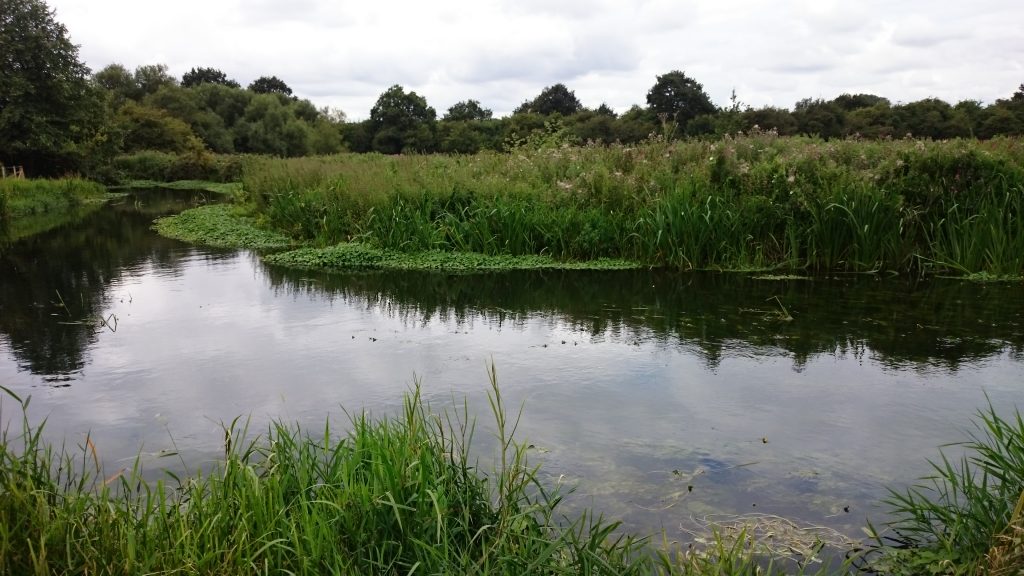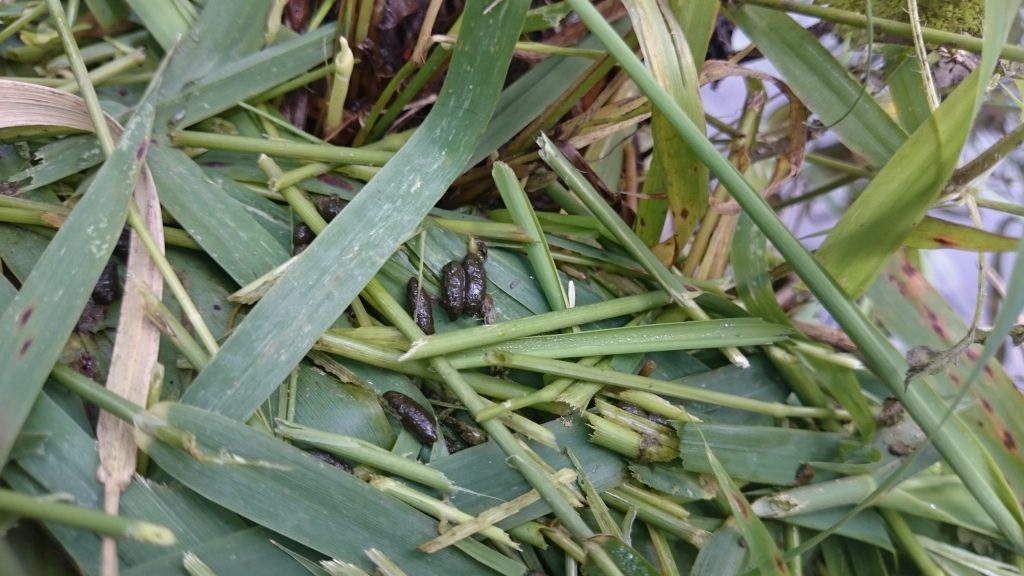Last month I spent a few hours with London Wildlife Trust‘s Conservation Ecologist Tony Wileman at Frays Farm Meadows SSSI, looking at water vole habitats. Water voles are Britain’s fastest declining mammal due to habitat destruction and massive predation. Everything from owls to kestrels and mustelids, particularly mink, prey on water voles. If mink enter a water vole habitat, they can decimate the population – and in many places have done just that.
Frays Farm Meadows sits next to Uxbridge Golf Course and is a rare example of wet meadow in Greater London. The Frays River runs through this area and it was along the banks of this river that we were looking for signs of water voles. Tony had warned us that we were highly unlikely to actually see any water voles; if you’re a water vole and you want to stay alive, you get very good at hiding at the first sign of anything approaching. Water voles are diurnal, generally only coming out to feed around dawn and dusk.
It’s easy enough to tell the difference between water voles and the rats that are quite common on river banks – water voles’ ears are covered in fur whereas rats’ ears protrude. Water voles’ faces are short and blunt where rat’s faces are longer and pointier. Rats are generally longer and sleeker in appearance, with a longer, hairless tail.

Water voles live almost entirely in the banks of rivers and ditches. They usually have at least a couple of golf ball-sized entrances into their burrows; one above the water, one at the water line and maybe one underneath the water. Their habitat needs to be covered in vegetation to allow them to evade predators – they move almost exclusively undercover. We saw a bank of the Frays River opposite us that clearly appeared to provide good water vole habitat, so we got closer to see if we could find any evidence of water vole activity.

Tony found a good looking area straight away, and we took a look by approaching it carefully from the meadow behind. A flattened area with food remains showed evidence of a feeding station – water voles find food from the vegetation 1-2 metres either side of the water’s edge and take it to a ‘safe’ area where they can eat it and keep a watch out for predators. The area was covered with nibbled food remains, as well as some droppings. From here they have access to jump off into the water (with a characteristic plopping sound) and swim to their burrow if necessary.

I’d been told about a telltale sign of water voles feeding – because they hold grasses and other vegetation in their paws to eat it, angled across the body, the ends of grasses have a distinctive 45 degree edge. This was clearly visible on much of the vegetation we picked up.

In the same area as the half-eaten vegetation we also found water vole droppings. Tony described these as being shaped like Tic Tacs, but they’re somewhere between a Tic Tac and a cigar. These might often be found in piles or latrines separate from the feeding station. These would be distinguishable from rat droppings based on being more uniformly shaped and having little or no odour due to the water voles’ mainly vegetarian diet, where the rat droppings would be foul smelling. As water voles consume mainly vegetation, they have to eat around 80% of their body weight every day.
All in one place then we had good evidence of water vole activity:
- A feeding station with half-eaten materials laid flat, forming a platform. We might also have expected to find a lawn, an area surrounding their burrow where the voles nibbled the grasses down.
- Vegetation which had been eaten leaving a 45 degree cut.
- Odourless droppings shaped like Tic Tacs or cigars found in small piles. We might also have expected to find latrines, distinctive piles of droppings used partly for territorial marking.
After leaving the habitat area we then surveyed the surrounding stretch of river bank from the opposite bank. Water voles live in steep river banks with a lot of vegetative cover as we already knew, but the suitability of the area as water vole habitat depends on various additional factors. Water voles are territorial, needing between 30 and 200 metres territory, and as Tony suggested, a water vole population is only viable in the long term with a minimum of 6km of continuous suitable watercourse.
The survey looked at conditions in-stream, at the bank sides, to the bank top and around the bordering land. We looked at various factors including:
- Whether the water was running, a ditch, or still – water voles may be found in rivers, ditches or ponds but prefer slow-flowing, meandering water
- Vegetation cover – water voles need ample vegetation whether aquatic or on the bank side and above as their territory is relatively small and it is dangerous for them to move too far from their burrows
- Whether anything was impeding water flow – water vole populations are viable in continuous unbroken suitable habitat; major obstacles such as weirs or concrete sides fragment this and split populations
- The angle of the bank and herb cover – water voles need moderately steep but not sheer banks and plenty of cover
By completing a relatively simple form we would be in a position to assess the suitability of a stretch of 50 metres or more for water vole habitat, and possibly make notes as to improvements needed to better support water voles.

In the case of this area of Frays Farm, cattle had previously poached the river bank; poaching in this case means that the cattle had trampled the river bank to eat vegetation at the edge of the river and drink from the river. Poaching leads to bank erosion, loss of vegetation and silt buildup in the water – this is damaging to water vole habitats and to the health of the river in general. To rectify this, London Wildlife Trust have erected fences along the bank edge to prevent the cattle from poaching, apart from at two points where they can reach the river to drink. In the longer term, the bank could recover to the point where water voles can occupy it.
Having surveyed the area, discussed the risks and seen the signs of water vole activity first hand I’d now be much more confident in assessing habitats and spotting the signs of water voles. One of these days it would be great to actually see one; for the time being, in a potential water vole habitat I would remember the following measures to improve their chances:
- Leaving at least alternating sections of river bank vegetation uncut to maintain cover and food source
- Cutting outside the breeding season between March and October.
- Not dumping cut materials into the river, and leaving the river clear.
- Preventing cattle poaching using fencing, as well as managing overhanging vegetation to avoid excessive cover that might affect bankside flora – for example by coppicing or pollarding riverside trees.
- Exercise caution around river banks to avoid excessive disturbance of burrows, for example by avoiding the use of heavy machinery.
The good news is, you can attend this workshop too if places are available – London Wildlife Trust are running further workshops in September and October and if juvenile water voles are around you may actually have a better chance of seeing one than I did. Find out more about the next workshops here.


Thank you that has been really enjoyable to read on my morning look through of websites; I did think that dawn and dusk activity was more called crepuscular than diurnal but really need to look that up, and I need to attend one of these days they sound very interesting. Thanks this was lovely to read Daniel
Many thanks indeed Dan, very much appreciated. It’s a funny one on the eating habits that I probably haven’t explained so well; they’re diurnal in that they’re active during the day but from what Tony said they are mainly out feeding around dawn and dusk (the dusk bit would make them crepuscular). I’d certainly encourage you to get booked onto one of the next sessions; Tony’s excellent.